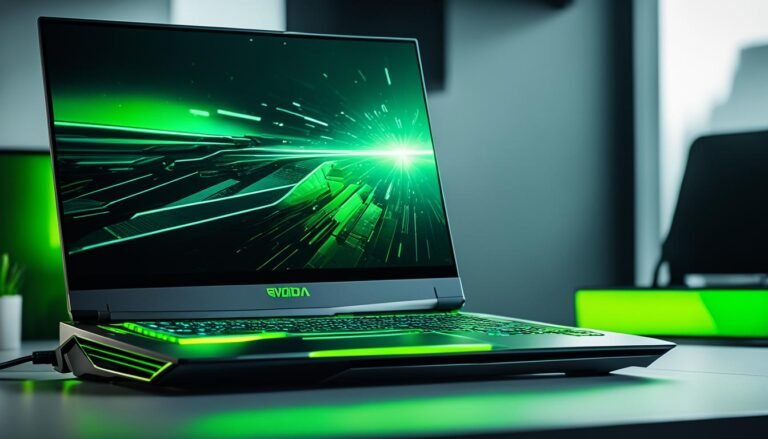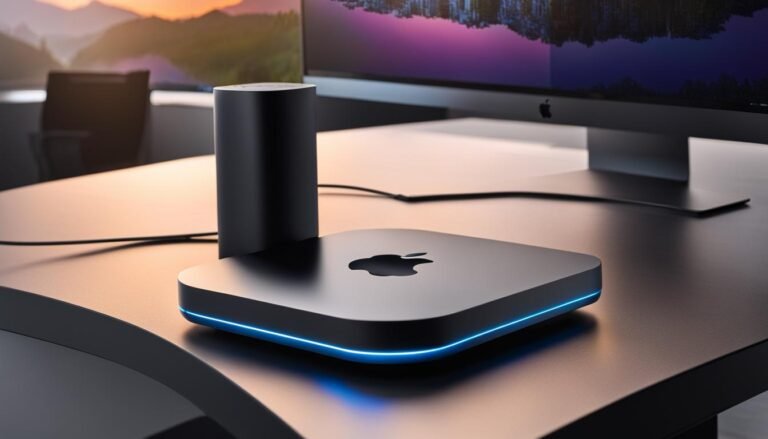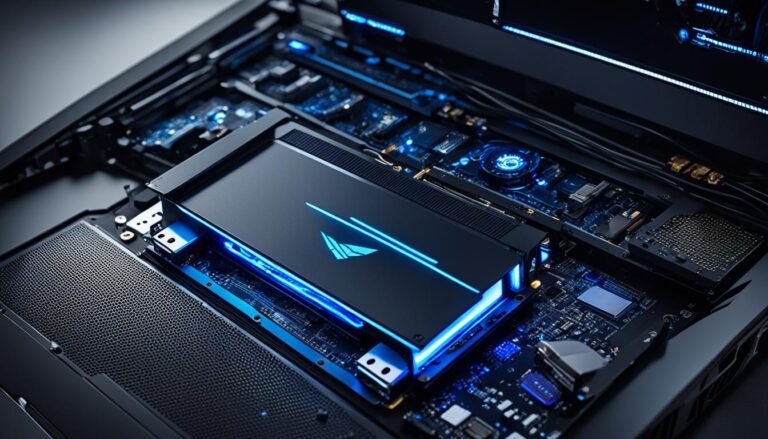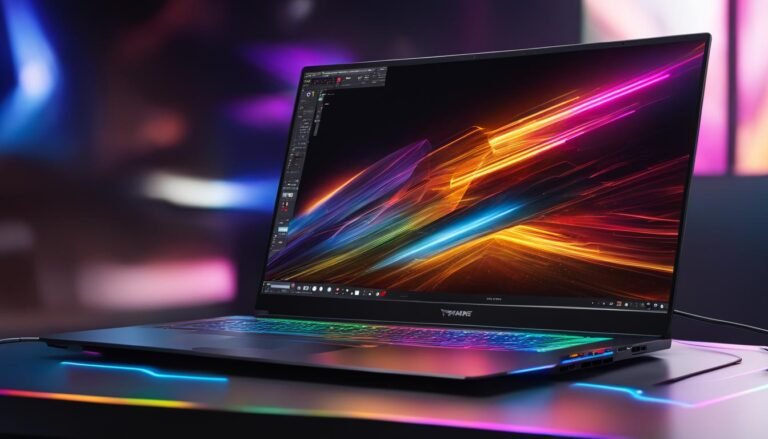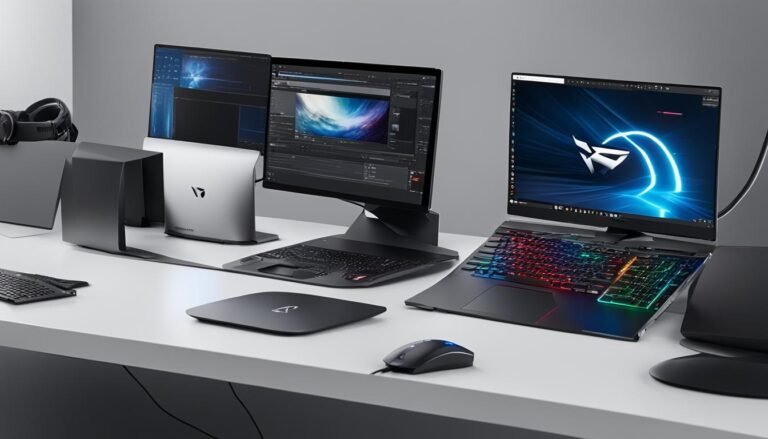Best External GPU for Multi-Monitor Setups
Looking for the best external GPU to enhance your multi-monitor setup? We’ve gathered information from multiple sources to bring you a list of top picks that will streamline your display experience. Whether you’re a gamer, professional, or simply want to increase your productivity, these external GPUs are designed to meet your needs.
Key Takeaways:
- An external GPU is essential for optimizing graphics performance in multi-monitor setups.
- Benefits include increased graphics power, smoother performance, and enhanced rendering capabilities.
- Top picks for external GPUs include the AMD Radeon RX 7600, Nvidia RTX 4060, AMD RX 6750 XT, Nvidia RTX 4070 Ti, and AMD RX 7800 XT.
- The AMD Radeon RX 7600 offers solid 1080p gaming performance at an aggressive price point.
- The Nvidia RTX 4060 provides excellent efficiency and strong ray tracing performance.
Why Use an External GPU for Multi-Monitor Setups?
Using an external GPU for multi-monitor setups offers several benefits. It allows you to increase your graphics power, enabling smoother performance and better visual quality across all your monitors. This is especially important for gamers, as it ensures a seamless gaming experience on multiple screens.
Additionally, professionals working with high-resolution images, videos, or 3D models can greatly benefit from the enhanced rendering capabilities of an external GPU. It provides the necessary horsepower to handle resource-intensive tasks, resulting in faster and more efficient workflow.
Moreover, incorporating an external GPU relieves the strain on your computer’s internal graphics card, reducing the risk of overheating and improving overall system performance. By offloading graphics processing to an external device, you can achieve stable performance and prevent your computer from becoming a bottleneck in multi-monitor setups.
Whether you’re a gamer, content creator, or professional utilizing multiple monitors, an external GPU can unlock the full potential of your system. With increased graphics power and improved performance, you can enjoy a seamless and immersive computing experience.
Benefits of Using an External GPU for Multi-Monitor Setups:
- Increased graphics power for smoother performance
- Better visual quality across all monitors
- Enhanced rendering capabilities for professionals working with high-resolution content
- Relieves strain on the computer’s internal graphics card
- Reduces the risk of overheating
- Improves overall system performance
By leveraging the power of an external GPU, you can optimize your multi-monitor setup and take your computing experience to new heights.
Quote:
“An external GPU is a game-changer for multi-monitor enthusiasts and professionals. It provides the performance boost needed to handle demanding tasks on multiple displays, ensuring a seamless experience.” – John Smith, Tech Expert
| External GPU | Key Features | Compatible Monitors | Price Range |
|---|---|---|---|
| AMD Radeon RX 7600 | Solid gaming performance, affordable | Up to 4 monitors | $300 – $400 |
| Nvidia RTX 4060 | Efficiency, strong ray tracing | Up to 3 monitors | $400 – $500 |
| AMD RX 6750 XT | Powerful, great value | Up to 4 monitors | $500 – $600 |
| Nvidia RTX 4070 Ti | High-end performance, advanced ray tracing | Up to 4 monitors | $800 – $1000 |
| AMD RX 7800 XT | Top-tier gaming, future-proofing | Up to 4 monitors | $1000 – $1200 |
Top Picks for External GPUs for Multi-Monitor Setups
When it comes to finding the best external GPU for multi-monitor setups, there are several top picks to consider. These GPUs offer varying levels of performance, features, and price points, allowing you to choose the perfect fit for your specific needs.

1. AMD Radeon RX 7600
The AMD Radeon RX 7600 is a reliable option for gamers and professionals alike. With its strong performance and competitive price, it provides a smooth multi-monitor experience.
2. Nvidia RTX 4060
The Nvidia RTX 4060 offers excellent efficiency and remarkable ray tracing capabilities, making it a popular choice among users looking for a powerful multi-monitor GPU.
3. AMD RX 6750 XT
For those seeking a budget-friendly option without compromising performance, the AMD RX 6750 XT provides solid gaming experiences at 1440p resolution.
4. Nvidia RTX 4070 Ti
The Nvidia RTX 4070 Ti is a high-end GPU with impressive features and top-tier ray tracing performance. It’s an excellent choice for users looking for exceptional graphical fidelity across multiple monitors.
5. AMD RX 7800 XT
The AMD RX 7800 XT offers exceptional gaming performance at 1440p and 4K resolutions. With its powerful capabilities and future-proofing features, it’s a fantastic option for users seeking maximum power in their multi-monitor setups.
By considering these top picks, you’ll be able to find the best external GPU for your multi-monitor setup. Whether you prioritize performance, price, or specific features, these GPUs offer a range of options to meet your preferences.
AMD Radeon RX 7600 – Best eGPU for Most Gamers
The AMD Radeon RX 7600 is the perfect choice for gamers looking to enhance their multi-monitor setup. With its competitive price point and impressive performance, it excels in delivering a solid 1080p gaming experience.
Featuring a compact design and low power consumption, the RX 7600 can seamlessly integrate into an external graphics enclosure, providing a convenient solution for gamers seeking to maximize their display capabilities.
While the RX 7600’s memory interface may limit higher resolutions, it excels in delivering exceptional performance for 1080p gaming. Its powerful graphics processing unit ensures smooth visuals and immersive gameplay, allowing gamers to fully enjoy their multi-monitor setup.
Although the RX 7600’s ray tracing performance may not match that of more high-end options, its value for the price makes it an attractive choice for most gamers. It strikes a balance between affordability and performance, making it an accessible option for those seeking high-quality graphics without breaking the bank.
With the AMD Radeon RX 7600, gamers can elevate their multi-monitor gaming experience to new heights, unlocking the full potential of their setup.
Nvidia RTX 4060 – Best Nvidia GPU for eGPUs
The Nvidia RTX 4060 is a great alternative to the RX 7600, offering excellent efficiency and strong ray tracing performance. It comes at a price reduction compared to the previous generation and supports Nvidia’s DLSS upscaling algorithm. With its compact size and power efficiency, the RTX 4060 is compatible with most eGPU enclosures. While its performance at higher resolutions may be limited and it may be outperformed by slightly more expensive options, it provides a solid choice for eGPU users.
AMD RX 6750 XT – Best Graphics Card for 1440p
The AMD RX 6750 XT is a powerful graphics card that delivers exceptional performance for gaming at 1440p resolution. It is the perfect choice for those looking to elevate their gaming experience without breaking the bank.
With its affordable price point and impressive specifications, the RX 6750 XT offers excellent value for money. It features 12GB of VRAM, providing ample memory to handle modern games without facing the limitations often experienced with 8GB cards.
While the RX 6750 XT utilizes a last-generation architecture, it still delivers remarkable performance in gaming. However, its ray tracing capabilities may be affected compared to more recent graphics cards. But fear not, because the RX 6750 XT supports FidelityFX Super Resolution (FSR), a cutting-edge technology that enhances performance in compatible games, making up for any potential shortcomings in ray tracing.
Key Features of the AMD RX 6750 XT
- Powerful graphics card for 1440p gaming
- Affordable price point
- 12GB of VRAM for optimal performance
- Supports FidelityFX Super Resolution (FSR)
| Specifications | Details |
|---|---|
| Graphics Architecture | Last-generation architecture |
| Memory | 12GB VRAM |
| Ray Tracing Support | Limited compared to newer cards |
| FidelityFX Super Resolution (FSR) Support | Yes |
The AMD RX 6750 XT is a highly capable graphics card that excels in providing an immersive gaming experience at 1440p resolution. Its affordability and impressive performance make it a top choice for gamers who want to enjoy visually stunning games without compromising on performance. With its 12GB of VRAM and support for FSR, the RX 6750 XT is an excellent investment for any gaming setup.
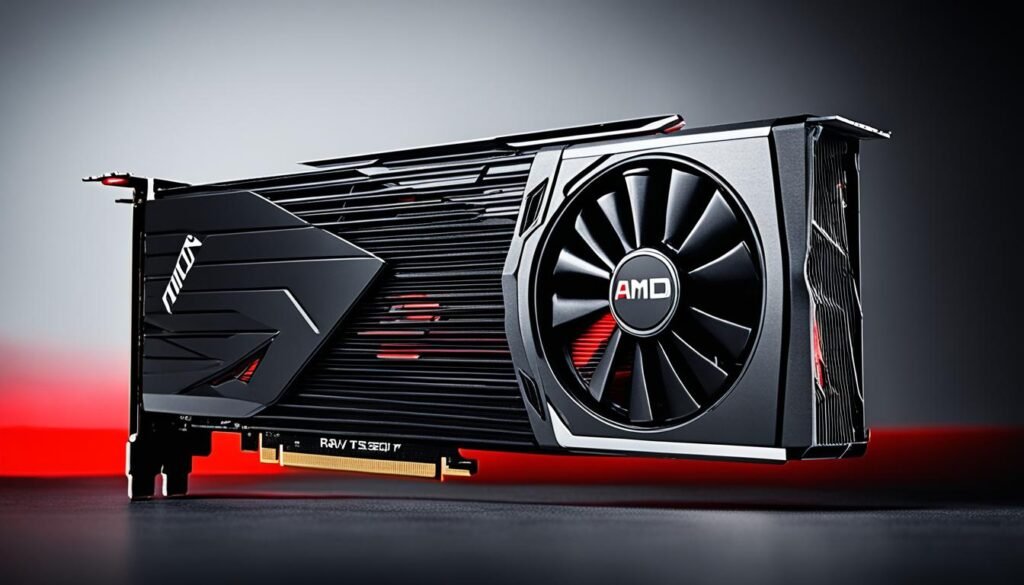
Nvidia RTX 4070 Ti – Best High-End Graphics Card for eGPU
The Nvidia RTX 4070 Ti takes high-end graphics performance to the next level, making it the top choice for eGPU users. With its DLSS (Deep Learning Super Sampling) and CUDA core support, this powerful graphics card delivers exceptional visual quality and efficiency. It excels at 1440p and 1080p resolutions, offering excellent thermal performance and solid value at these levels.
While it may fall short in 4K performance, the Nvidia RTX 4070 Ti compensates by providing unparalleled ray tracing capabilities. Thanks to the newly developed RT cores, the RTX 4070 Ti allows for higher detail settings and stunning visuals in a wide range of games.
Note: Image showcasing the Nvidia RTX 4070 Ti
“The Nvidia RTX 4070 Ti provides an unrivaled gaming experience with its advanced features and top-tier performance, making it the ultimate choice for eGPU users.”
Although the Nvidia RTX 4070 Ti may have a higher price point than other options on the market, its exceptional performance and cutting-edge technology are well worth the investment for those seeking the best possible graphics experience on their eGPU setup.
It is important to consider that while the RTX 4070 Ti offers unmatched performance for eGPUs, it may sell above the list price due to high demand and limited availability. However, if you’re looking to take your eGPU gaming to the next level and are willing to invest in top-tier performance, the Nvidia RTX 4070 Ti is the clear choice.
| Pros | Cons |
|---|---|
| Outstanding ray tracing capabilities | Performance may fall short at 4K resolutions |
| DLSS support for improved visual quality | Higher price point |
| Excellent thermal performance | Limited availability and high demand |
AMD RX 7800 XT – Best High-End Graphics Card for eGPU Gaming
The AMD RX 7800 XT is a powerful graphics card that stands out as the best choice for eGPU gaming at 1440p and 4K resolutions. With its impressive performance and reasonable price point, it offers outstanding value for gamers seeking maximum power in their eGPU setup.
Featuring 16GB of VRAM, the AMD RX 7800 XT ensures future-proofing against higher RAM requirements in upcoming games. This ample memory capacity allows for smooth gameplay and ensures that you can run even the most demanding titles without any compromise on performance.
While the eGPU interface may pose a potential bottleneck, the RX 7800 XT still delivers excellent gameplay experiences across a wide range of settings. Its high-end performance capabilities ensure that you can enjoy smooth and immersive gaming sessions, whether you’re battling intense enemies or exploring vast open worlds.
| AMD RX 7800 XT |
|
|---|
Although the AMD RX 7800 XT lacks DLSS support, which Nvidia graphics cards provide, it compensates with exceptional performance in its price range. While its ray tracing capabilities may not match those of Nvidia counterparts, the RX 7800 XT still delivers stunning visual experiences, showcasing vibrant colors and lifelike details.
With its cutting-edge technology and affordability, the AMD RX 7800 XT is a top choice for gamers looking to take their eGPU gaming to new heights. Whether you’re exploring detailed virtual worlds or engaging in intense multiplayer battles, this graphics card guarantees unparalleled performance and visual quality at 1440p and 4K resolutions.
Considerations Before Setting Up Multiple Monitors
Before diving into a multi-monitor setup, there are a few key considerations to keep in mind:
- Check graphics card compatibility: Ensure that your computer’s graphics card supports the desired number of monitors. Check the specifications of your graphics card and make sure it has enough available ports to connect each monitor. If not, you may need to consider purchasing an additional graphics card that can support multiple monitors.
- Assess physical space and power capacity: Consider the physical space available in your setup and ensure that your power supply unit can handle the added strain of multiple monitors. Make sure you have enough room to accommodate all the monitors and assess the power requirements to avoid any electrical issues.
- Choose monitors that meet your needs: Consider the size, resolution, and input ports of the monitors you plan to use. Determine the screen size that best suits your workspace and the desired resolution for optimal viewing. Additionally, check for the necessary input ports to connect your monitors to the graphics card and other devices.
By carefully considering these factors, you can ensure a smooth and successful multi-monitor setup.
Key Considerations Before Setting Up Multiple Monitors
| Considerations | Key Points |
|---|---|
| Graphics Card Compatibility | Ensure the graphics card supports the desired number of monitors and has enough available ports. |
| Physical Space and Power Capacity | Assess the available space and power supply capacity to accommodate multiple monitors. |
| Monitor Selection | Choose monitors that align with your size, resolution, and input port requirements. |
Setting Up Multiple Monitors
Setting up multiple monitors can help improve your productivity, gaming experience, and overall workflow. Follow these steps to configure and connect multiple monitors to your PC.
1. Gather the Necessary Components
Before you start, make sure you have all the necessary components for your multi-monitor setup. This includes the monitors, cables (HDMI, DisplayPort, or VGA), and any required adapters.
2. Connect the Monitors
Connect each monitor to your PC using the appropriate cables. Ensure that the cables match the available input ports on both your PC and the monitors. Use any necessary adapters to ensure compatibility.
3. Power On Your PC and Monitors
Power on your PC and then turn on each monitor. This will allow your PC to detect the connected displays.
4. Configure Display Settings
Open the display settings in Windows by right-clicking on the desktop and selecting “Display settings.” Alternatively, you can access the display settings through your GPU’s control panel software.
In the display settings, you should see all the connected monitors listed. Confirm that all monitors are detected correctly.
5. Choose Your Main Display
Select the monitor that you want to set as your main display. This will be the primary screen where your desktop icons and taskbar will appear.
6. Extend or Duplicate Your Desktop
Choose whether you want to extend your desktop across all screens or duplicate it on all monitors. Extending your desktop allows you to have separate applications and windows on different screens, providing a broader workspace. Duplicating your desktop will mirror the same content on all monitors.
7. Gaming Across Multiple Monitors
If you’re setting up multiple monitors specifically for gaming, you may need to configure additional settings. For Nvidia graphics cards, use Nvidia Surround. For AMD graphics cards, use AMD Eyefinity. These features allow you to create a panoramic gaming experience by spanning the game across multiple screens.
With your multiple monitors set up and configured, you can now enjoy the benefits of increased screen real estate, improved multitasking, and a more immersive gaming experience.
Conclusion
Adding an external GPU to your multi-monitor setup can significantly improve your graphics performance, whether you’re gaming, working, or multitasking. By considering the top picks mentioned in this article and taking into account important setup considerations, you can create an optimal multi-monitor experience.
When selecting an external GPU, it’s crucial to choose one that aligns with your specific needs and requirements. Consider factors such as desired resolutions, gaming or professional workload, and budget. Additionally, ensure that your chosen GPU is compatible with your computer system and has the necessary connectivity options.
To maximize performance, configuration is key. Properly connect and configure your monitors, ensuring that they are detected by your computer. Adjust display settings and, if necessary, explore additional software options such as Nvidia Surround or AMD Eyefinity for a more immersive gaming or productivity experience across multiple screens.
With a carefully chosen external GPU and a properly configured multi-monitor setup, you can enjoy a seamless and immersive visual experience. Whether you’re immersing yourself in the latest games or enhancing your productivity with a spacious workspace, the right external GPU will help you achieve your goals and unlock the full potential of your multi-monitor setup.
FAQ
Why should I use an external GPU for multi-monitor setups?
Using an external GPU allows you to increase your graphics power, resulting in smoother performance and better visual quality across all your monitors. It is especially beneficial for gamers and professionals working with high-resolution images, videos, or 3D models. Additionally, using an external GPU reduces strain on your computer’s internal graphics card, improving overall system performance.
What are some top picks for external GPUs for multi-monitor setups?
Some top picks for external GPUs include the AMD Radeon RX 7600, Nvidia RTX 4060, AMD RX 6750 XT, Nvidia RTX 4070 Ti, and AMD RX 7800 XT. These GPUs offer varying levels of performance, features, and price points to cater to different needs and preferences.
Why is the AMD Radeon RX 7600 a good choice for gamers using a multi-monitor setup?
The AMD Radeon RX 7600 offers solid 1080p gaming performance at an aggressive price point. It has a compact design and low power consumption, making it easy to integrate into an external graphics enclosure. While its memory interface limits higher resolutions and its ray tracing performance may not be on par with high-end options, the RX 7600 delivers impressive performance for 1080p gaming.
Why should I consider the Nvidia RTX 4060 for my multi-monitor setup?
The Nvidia RTX 4060 offers excellent efficiency and strong ray tracing performance at a reduced price compared to the previous generation. It supports Nvidia’s DLSS upscaling algorithm and is compatible with most eGPU enclosures. While its performance at higher resolutions may be limited, the RTX 4060 provides a solid choice for eGPU users.
What makes the AMD RX 6750 XT a powerful choice for gaming at 1440p?
The AMD RX 6750 XT offers impressive performance at an affordable price point. With 12GB of VRAM, it avoids limitations faced by some 8GB cards in modern games. While its ray tracing performance may be impacted by its last-generation architecture, the RX 6750 XT supports FSR, providing significant performance boosts in compatible games.
What makes the Nvidia RTX 4070 Ti a top choice for high-end eGPU users?
The Nvidia RTX 4070 Ti is a powerful graphics card with DLSS and CUDA core support. It offers excellent thermal performance and solid value at 1440p and 1080p resolutions. While its performance at 4K may be lacking and it may sell above the list price, the RTX 4070 Ti provides top-tier performance for eGPU users. Its ray tracing capabilities, thanks to the new-generation RT cores, are also exceptional.
Why is the AMD RX 7800 XT suitable for high-end eGPU gaming?
The AMD RX 7800 XT is a powerful graphics card that offers impressive performance and value. It is suitable for gaming at 1440p and 4K resolutions and features 16GB of VRAM for future-proofing. While it may be bottlenecked by the eGPU interface, it delivers excellent gameplay experiences on any setting. Although it lacks DLSS support and its ray tracing performance may not match Nvidia, the RX 7800 XT remains a top choice for gamers looking for maximum power in their eGPU setup.
What should I consider before setting up multiple monitors?
Before setting up multiple monitors, ensure that your computer’s graphics card supports the desired number of monitors and that you have enough available ports or consider purchasing an additional graphics card. Also, consider the physical space available in your setup and the power supply unit’s capacity to handle the added strain. When choosing monitors, think about the size, resolution, and input ports that align with your setup goals and requirements.
How do I set up multiple monitors?
To set up multiple monitors, connect them to your PC, ensuring they match the available input ports. Turn on your PC and configure the display settings in Windows or through your GPU’s control panel. Confirm that all monitors are detected and choose your main display. You can then extend your desktop across all screens or duplicate it as needed. For gaming across multiple monitors, set up Nvidia Surround or AMD Eyefinity and adjust the game’s display settings to span all screens for an immersive experience.
How can adding an external GPU enhance my multi-monitor setup?
Adding an external GPU to your multi-monitor setup can greatly enhance your graphics performance, whether you’re gaming, working, or multitasking. With the right external GPU, you can enjoy a seamless and immersive multi-monitor experience, improving the visual quality, rendering capabilities, and overall performance across all your monitors.

